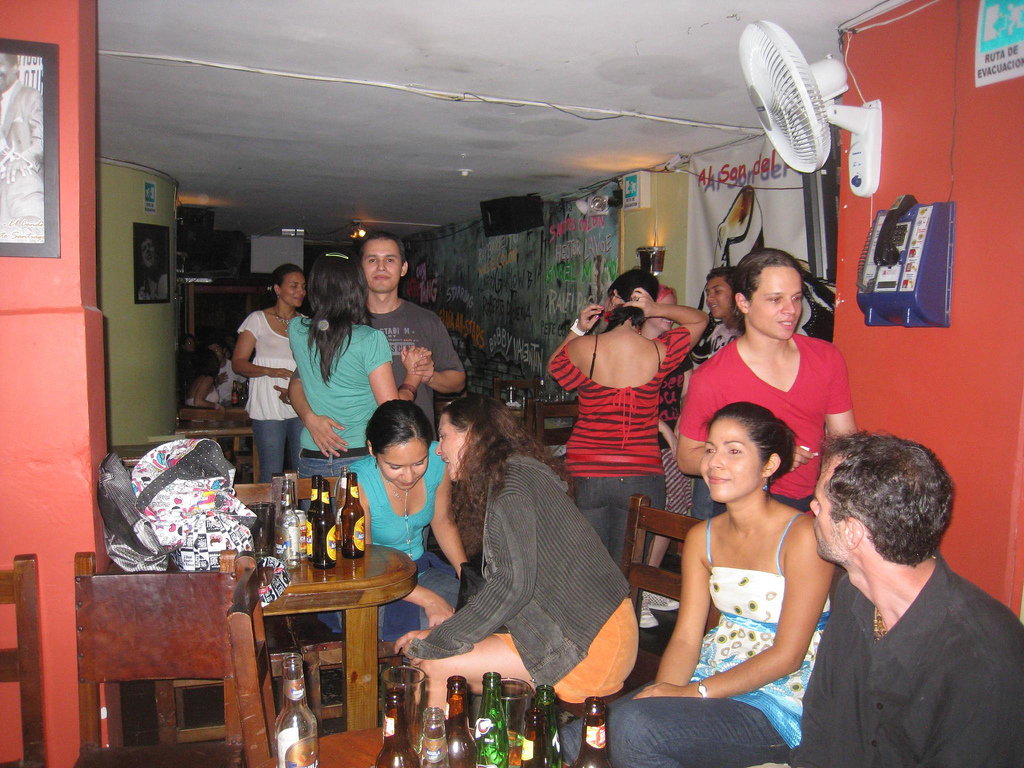The following is a guest post by Peter Low.
To make the most out of a visit to Medellín, there is no substitute for spending some time socializing with the city’s friendly residents. (And to do that effectively, you’ll need to learn some Colombian Spanish.)
Paisas are an incredibly welcoming bunch and often make a real effort to help foreigners integrate into local social circles.
However, without knowing some key bits of vocab, you might not fully understand what your new friends are talking about or even what you’re being invited to.
To help those new to the city to integrate more easily, here’s a beginner’s Spanish survival guide to a few popular terms used by Colombians when talking about social activities.
Rumbear
“Rumba” is technically a sort of music/dance originating in Cuba, but in Colombia this word is used almost exclusively as a term for “party.”
It is often heard as a verb, “rumbear,” as in “to party:” “estuve rumbeando todo el finde” (“I was partying the whole weekend”).
Other slightly less common ways to talk about this important social activity include the phrases: “parrandear” from parranda, a synonym of rumba, or “ir de farra” or “farrear” from farra, another synonym.
Aguardiente / Guaro
Medellín’s number one choice of tipple – for young and old, men and women, alike – is “aguardiente,” an aniseed-flavoured spirit made in the country.
Frankly, it isn’t the greatest drink in the world but seems to feature in almost any social event where alcohol is involved.
For outsiders, accepting a shot of “guaro,” as it is affectionately also known, is a good way to break the ice when being introduced to a new group of people.
Finca
If you are ever invited to a party outside of the city, chances are it will be held in a “finca,” a rural dwelling roughly translating as country or farmhouse.
There are two main sorts. Those in “tierra caliente,” or the warmer regions of Colombia, almost always have an outdoor swimming pool as their main attraction.
Those in the cooler “tierra fria,” on the other hand, are designed much more like a traditional farm-house.
Both types are typically set-up for hosting lots of people, with a few bedrooms containing multiple beds to maximize capacity.
Parties at “fincas” are particularly popular among those still living in the family home (i.e. most young people) as they offer an escape from the strict Catholic rules which govern many family households. The opportunity to misbehave is rarely wasted.
Parche
In your dictionary, the word “parche” is likely to be translated just as a “patch.” In Colombia, “parche” is a slang term meaning something like: “a group of friends getting together to do something.”
By turning this into a verb, “parchar,” it becomes a way of saying “to hang out [with friends].” For example, you might say “nosotros siempre parchamos en el parque” (“we always hang out in the park”).
At the other end of the spectrum, “estar desparchado/a” means that you’ve not got much going on in your social life, and implies that you’re a bit down as a result.
Tomar “el algo”
If someone invites you to “tomar el algo” (literally “to have ‘the something’”) they are asking if you want to meet mid-afternoon for a relaxed drink and perhaps something small to eat.
The same activity is also described by the term “tardear” (lit. “to afternoon”). This custom, kind of like a much more informal Colombian “afternoon tea,” tends to be more popular among women than men.
Chiva
Technically speaking, a “chiva” is the word for a female goat, but it is also a term for the brightly colored, wooden-topped, open-air buses which were traditionally common in the Colombian countryside.
Nowadays, it is rare to see “chivas” being used as a straightforward mode of transport. Instead, you are most likely to come across (a renovated version of) these vehicles in cities where they are used as party buses.
While not a regular feature of the Colombian social scene, they occasionally make an appearance for special events, such as milestone birthdays.
Cabalagata
The best way to describe a “cabalagata” is as a “bar crawl on horseback.” They are both as fun, and as dangerous, as they sound.
A several thousand person strong “cabalagata” used to be one of the headline events at the annual Flower Festival in Medellín, but has been removed in recent years due to the many injuries often sustained by both man and beast.
It’s still a popular event in other cities of the country, such as Manizales.
Remate
A “remate” is the “after party.” So, leaving a club in Parque Lleras at 3 a.m., a still buzzing friend might ask: “Entonces ¿en dónde es el remate?” (“So…where’s the after party at?”). It can also be used as a verb “rematar.”
Guayabo
A fitting term on which to end this introductory guide. After the “rumba” and the “remate,” and long after the “guaro” has run out, you might start to feel the “guayabo” (or “hangover”) kick in.
Fortunately, Colombians seem to be sympathetic towards those suffering the after-effects of the night before and have invented the phrase “pasar guayabo” to mean “[spending time] getting over your hangover.”
Say to anyone that you are “pasando guayabo” and they tend to immediately lose any expectations of you doing anything that day. Perfect for those needing some rest before the next night out on the town.
Editor’s note: If you found Peter’s tips helpful, check out his new Colombian Spanish ebook.












